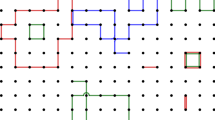Abstract
We study the complexity of computing average quantities related to spin systems, such as the mean magnetization and susceptibility in the ferromagnetic Ising model, and the average dimer count (or average size of a matching) in the monomer-dimer model. By establishing connections between the complexity of computing these averages and the location of the complex zeros of the partition function, we show that these averages are #P-hard to compute, and hence, under standard assumptions, computationally intractable. In the case of the Ising model, our approach requires us to prove an extension of the famous Lee–Yang Theorem from the 1950s.
Similar content being viewed by others
References
Agrawal M., Kayal N., Saxena N.: PRIMES is in P. Ann. Math. 160(2), 781–793 (2004)
Arora S., Barak B.: Computational Complexity: A Modern Approach. Cambridge University Press, Cambridge (2009)
Asano T.: Lee–Yang theorem and the Griffiths inequality for the anisotropic Heisenberg ferromagnet. Phys. Rev. Lett. 24(25), 1409–1411 (1970)
Biskup, M.: (2012). Personal Communication
Biskup M., Borgs C., Chayes J., Kleinwaks L., Kotecký R.: Partition function zeros at first-order phase transitions: a general analysis. Commun. Math. Phys. 251(1), 79–131 (2004)
Biskup M., Borgs C., Chayes J., Kotecký R.: Partition function zeros at first-order phase transitions: Pirogov–Sinai theory. J. Stat. Phys. 116(1), 97–155 (2004)
Borcea J., Brändén P.: The Lee–Yang and Pólya-Schur programs. I. Linear operators preserving stability. Invent. Math. 177(3), 541–569 (2009)
Borcea J., Brändén P.: Pólya-Schur master theorems for circular domains and their boundaries. Ann. Math. 170(1), 465–492 (2009)
Brune, O.: Synthesis of a finite two-terminal network whose driving-point impedance is a prescribed function of frequency. Sc. D. Thesis, MIT (1931)
Bulatov A.: A dichotomy theorem for constraint satisfaction problems on a 3-element set. J. ACM 53, 66–120 (2006)
Bulatov A., Grohe M.: The complexity of partition functions. Theor. Comput. Sci. 348(2–3), 148–186 (2005)
Cai, J.Y., Chen, X.: Complexity of counting CSP with complex weights. In: Proc. ACM Symp. Theory Comput. (STOC) 2012, pp. 909–920. ACM, New York (2012)
Cai, J.Y., Chen, X., Lu, P.: Graph homomorphisms with complex values: A dichotomy theorem. In: Proc. Int. Colloq. Autom. Lang. Program. (ICALP) 2010, pp. 275–286. Springer, Berlin (2010)
Cai, J.Y., Kowalczyk, M.: A dichotomy for k-regular graphs with {0, 1}-vertex assignments and real edge functions. In: Proc. Conf. Theory Appl. Model. Comput. (TAMC) 2010, pp. 328–339. Springer, Berlin (2010)
Choe Y.B., Oxley J.G., Sokal A.D., Wagner D.G.: Homogeneous multivariate polynomials with the half-plane property. Adv. Appl. Math. 32(1–2), 88–187 (2004)
Chudnovsky M., Seymour P.: The roots of the independence polynomial of a clawfree graph. J. Comb. Theory Ser. B 97(3), 350–357 (2007)
Clark R.: The Routh–Hurwitz stability criterion, revisited. IEEE Control Syst. 12(3), 119–120 (1992)
Cook, S.A.: The complexity of theorem-proving procedures. In: Proc. ACM Symp. Theory Comput. (STOC) 1971, pp. 151–158. ACM, New York (1971)
Dyer M.E., Greenhill C.S.: The complexity of counting graph homomorphisms. Random Struct. Algorithms 17(3–4), 260–289 (2000)
Edmonds J.: Paths, trees, and flowers. Can. J. Math. 17(0), 449–467 (1965)
Edmonds J.: Systems of distinct representatitives and linear algebra. J. Res. Natl. Bur. Stand. Sect. B 71B(4), 241–245 (1967)
Goldberg L.A., Grohe M., Jerrum M., Thurley M.: A complexity dichotomy for partition functions with mixed signs. SIAM J. Comput. 39(7), 3336–3402 (2010)
Goldberg L.A., Jerrum M., Paterson M.: The computational complexity of two-state spin systems. Random Struct. Algorithms 23, 133–154 (2003)
Griffiths R.B.: Correlations in Ising ferromagnets. Int. J. Math. Phys. 8(3), 478–483 (1967)
Heilmann O.J., Lieb E.H.: Monomers and dimers. Phys. Rev. Lett. 24(25), 1412–1414 (1970)
Heilmann O.J., Lieb E.H.: Theory of monomer–dimer systems. Commun. Math. Phys. 25(3), 190–232 (1972)
Jerrum M., Valiant L.G., Vazirani V.V.: Random generation of combinatorial structures from a uniform distribution. Theor. Comput. Sci. 43, 169–188 (1986)
Karp, R.M.: Reducibility among combinatorial problems. In: Proc. Complexity of Computer Computations, pp. 85–103. Plenum Press, New York (1972)
Laguerre, E.: Sur les fonctions du genre zéro et du genre un. C. R. Acad. Sci. 98 (1882)
Lee T.D., Yang C.N.: Statistical theory of equations of state and phase transitions. II. Lattice gas and Ising model. Phys. Rev. 87(3), 410–419 (1952)
Levin L.A.: Universal search problems. Probl. Inf. Transm. 9(3), 265–266 (1973)
Macon N., Dupree D.E.: Existence and uniqueness of interpolating rational functions. Am. Math. Monthly 69(8), 751–759 (1962)
Newman C.M.: Zeros of the partition function for generalized Ising systems. Commun. Pure Appl. Math. 27(2), 143–159 (1974)
Newman C.M.: The GHS inequality and the Riemann hypothesis. Constr. Approx. 7(1), 389–399 (1991)
Papadimitriou C.H.: Computational Complexity. Addison-Wesley, Boston (1994)
Pólya G., Schur I.: Über zwei Arten von Faktorenfolgen in der Theorie der Algebraischen Gleichungen. J. Reine Angew. Math. 144, 89–113 (1914)
Ruelle D.: Statistical Mechanics. W. A. Benjamin Inc., Detroit (1983)
Sly, A.: Computational transition at the uniqueness threshold. In: Proc. IEEE Symp. Found. Comput. Sci. (FOCS) 2010, pp. 287–296. IEEE Computer Society, New York (2010)
Sly, A., Sun, N.: The computational hardness of counting in two-spin models on d-regular graphs. In: Proc. IEEE Symp. Found. Comput. Sci. (FOCS) 2012, pp. 361–369. IEEE Computer Society, New York (2012)
Suzuki M., Fisher M.E.: Zeros of the partition function for the Heisenberg, ferroelectric, and general Ising models. J. Math. Phys. 12(2), 235–246 (1971)
Valiant L.G.: The complexity of computing the permanent. Theor. Comput. Sci. 8, 189–201 (1979)
Valiant L.G.: The complexity of enumeration and reliability problems. SIAM J. Comput. 8(3), 410–421 (1979)
Weitz, D.: Counting independent sets up to the tree threshold. In: Proc. ACM Symp. Theory Comput. (STOC) 2006, pp. 140–149. ACM, New York (2006)
Yang C.N., Lee T.D.: Statistical theory of equations of state and phase transitions. I. Theory of condensation. Phys. Rev. 87(3), 404–409 (1952)
Author information
Authors and Affiliations
Corresponding author
Additional information
Communicated by F. Toninelli
An extended abstract of this paper appeared in the proceedings of the annual ACM Symposium on the Theory of Computing (STOC), 2013, pp. 625–634.
Rights and permissions
About this article
Cite this article
Sinclair, A., Srivastava, P. Lee–Yang Theorems and the Complexity of Computing Averages. Commun. Math. Phys. 329, 827–858 (2014). https://doi.org/10.1007/s00220-014-2036-7
Received:
Accepted:
Published:
Issue Date:
DOI: https://doi.org/10.1007/s00220-014-2036-7



